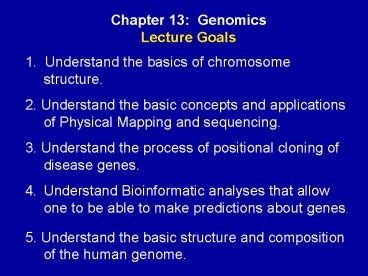IGA 8e PowerPoint PPT Presentation
1 / 19
Title: IGA 8e
1
- Chapter 13 Genomics
- Lecture Goals
- 1. Understand the basics of chromosome
structure. - 2. Understand the basic concepts and applications
of Physical Mapping and sequencing. - 3. Understand the process of positional cloning
of disease genes. - Understand Bioinformatic analyses that allow one
to be able to make predictions about genes. - 5. Understand the basic structure and composition
of the human genome.
2
Genomics deals with the molecular
characterization of whole genomes This
includes Physical and genetic mapping.
Localization and characterization of specific
elements. Studying the evolution of
genomes and the complete sequencing of
genomes. This chapter deals almost
exclusively with eukaryotic genomes.
3
- Characterization of chromosomes.
- Identify, number and characterize chromosomes
at an ultrastructural level. - Observe staining pattern of mitotic
chromosomes, note numbers and size. - Identify loci specific markers for
chromosomes.
4
Karyotypes Arrange chromosomes by size,
shape, centromeric location and banding pattern.
5
Genetic Mapping of Chromosomes Genetic mapping
utilizes genetic linkage and meiotic
recombination frequencies to determine how
closely linked (if at all) 2 markers (or 1 marker
and a phenotype) are to each other. Genetic maps
are critical for identifying the gene responsible
for an aberrant phenotype, such a genetic
disease. Genetic mapping of chromosomes was
covered in Chapter 4 and will not be discussed
here except to mention.
6
- Genetic Map of Xenopus tropicalis is being
produced at the University of Houston. - http//tropmap.biology.uh.edu
- This is the first genetic map ever made for an
amphibian. - It currently contains about 1500 markers.
- An addition 1500 markers will be added this
summer. - In September, the final map will be presented
the - International Xenopus conference in
Germany.
7
- Physical Mapping of Chromosomes
- Physical mapping involves determining physical
links between loci. - 2. The production of overlapping cloned maps or
contigs is a common method of physically
linking loci. - 3. The most common method for producing contig
maps is to link individual clones together by
virtue of the fact that they both contain a PCR
amplifiable marker, STS.
8
The most common method for producing contig maps
is to link individual clones together by virtue
of the fact that they both contain a PCR
amplifiable marker, STS.
9
Assembly of an STS content map.
The cloned fragments can then be sequenced and
aligned.
10
Sequence Assembly
The overlapping contigs are then subcloned
and individual subclones are sequenced and
assembled
11
Fluorescent in situ hybridization (FISH) to
chromosome spreads can verify chromosomal
location of large cloned fragments.
FISH using chromosome 21 specific probe.
DNA probes labeled with fluorescing dye
bind complementary DNA on the chromosome.
Can be done on interphase or metaphase
chromosomes.
12
Today the initial production and alignment of
cloned fragments prior to sequencing is often
omitted.
13
Positional cloning (identification) of a gene.
Cloning a gene without knowing its protein or
function. Through genetic linkage, map the
disease phenotype to chromosomal location.
Use chromosomal deletions or
rearrangements (if available) to more
precisely map the gene. Develop a physical
contig map of the region. Identify genes in
the region. Test the genes for mutations
that segregate with the disease phenotype.
14
Case Study Positional cloning Hereditary
Multiple Exostoses Multiple cartilaginous
exostoses (tumors). Short stature
Shortened and bowed forearms Hindered
articular function Pressure on nerves and
blood vessels Malignant degeneration
Autosomal dominant inheritance
15
Through genetic linkage, map the disease
phenotype to a chromosomal location. D8S99
and D8S200 are polymorphic Microsatellite Markers.
Chromosome 8
16
Use chromosomal deletions or rearrangements to
more precisely map the gene.
17
Develop a physical contig map of the region.
18
- Once a small region is identified
- Find all of the genes in the region through
Bioinformatic - approaches (making predictions base on
sequence - content.)
2. Test the genes for mutations that segregate
with the disease phenotype (confirm genetic
linkage).
19
Structure of the Human Genome.
1. Contains about 3 billion base pairs and
20-25,000 genes. 2. About 45 is repetitive
sequence including Centromere is the
largest constriction of the chromosome and
where the spindle fibers attach during cell
division. The bases that form the
centromere are 171-base repeats (Alpha
satellites). Telomeres are chromosome
tips composed of many repeats of
TTAGGG and shorten with each cell division.
Transposable elements (ex. Alu 300bp-500,000
copies) and processed pseudogenes
(19,000). 3. mRNA sequences represent less than
3 of the genome.

